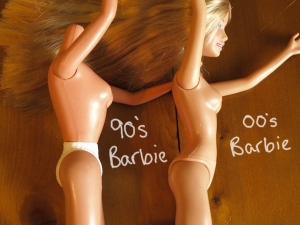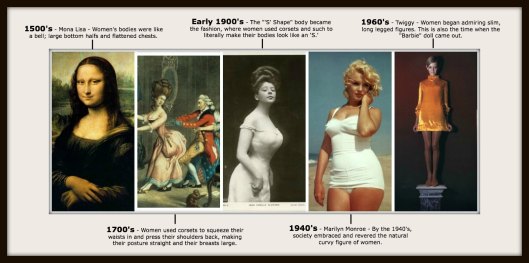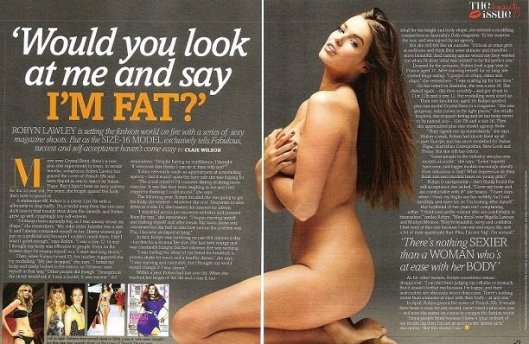Tags
Body Image, Eating Disorders, Fashion, Health, Model, Robyn Lawley, Sexy, Skinny, Women
When did SKINNY become the new SEXY?
I remember the first time a friend ever told me about her eating disorder. She was just past 13 years old, and I was only 11. We stood in a hotel lobby with unfortunate maroon carpets, and she mentioned being bulimic so nonchalantly, she may as well have been remarking about the relentless rain sputtering against the tall windows outside. I was shocked. As a curvy girl at age 11 with two skinny sisters, I was a bit insecure with my body, but I could not fathom why my naturally thin and beautiful friend would ever think so detrimentally of herself that she would resort to an eating disorder. I remember forcing back tears as I tried to form a response. When I recovered enough from the shock and found words, I told her she was beautiful and didn’t need to hurt her body. She got help through our church’s youth pastor and learned to accept her body. But countless girls facing the same struggle aren’t always so lucky.
Society and Media’s Affect on Body Image
 As a popular image that has been circling the Web, many of you may have seen this and wondered not only when, but why skinny women are now revered while curvy, healthy ones used to be. Well, the truth is, it’s happening because of us. By accepting the ridiculously high standards and imposed idea of beauty that society and media force upon us, we agree that being skinny is the only way to be beautiful. This idea that skinny = beautiful has subconsciously grown in our minds from as early as our childhood days while playing with Barbies. Pictured here is a Barbie doll from the 90’s,
As a popular image that has been circling the Web, many of you may have seen this and wondered not only when, but why skinny women are now revered while curvy, healthy ones used to be. Well, the truth is, it’s happening because of us. By accepting the ridiculously high standards and imposed idea of beauty that society and media force upon us, we agree that being skinny is the only way to be beautiful. This idea that skinny = beautiful has subconsciously grown in our minds from as early as our childhood days while playing with Barbies. Pictured here is a Barbie doll from the 90’s, alongside a newer, significantly skinnier, version that came out only 10 years later. As young impressionable girls, being subjected to this plastic idea of perfection was only the mere beginning of our obsession with beauty, body image, and self perfection.
alongside a newer, significantly skinnier, version that came out only 10 years later. As young impressionable girls, being subjected to this plastic idea of perfection was only the mere beginning of our obsession with beauty, body image, and self perfection.
Statistically Speaking
- The average American woman is 5’4″ tall and weighs 140lbs, while the average American model is 5’11” and weighs only 117lbs. [1]
- Most fashion models are thinner than 98% of American women. [1]
- A study found that 69% of female television characters are unusually thin and only 5% are larger than the average-sized woman [2]
- It is estimated that 8 million Americans have an eating disorder – seven million women and one million men [3]
- A study by the National Association of Anorexia Nervosa and Associated Disorders reported that 5–10% of anorexics die within 10 years after contracting the disease; 18-20% of anorexics will be dead after 20 years and only 30–40% ever fully recover [3]
- 95% of those who have eating disorders are between the ages of 12 and 25 [3]
- 80% of 13-year-olds have attempted to lose weight [3]
It wasn’t always this way (click to enlarge)

A Woman Standing Up for a Healthy Body Image
 Robyn Lawley, a gorgeous 6’2″ size 12 model from Australia, is quickly becoming a recognized face–and body–in the fashion industry today. She is the first plus size model to ever appear on the cover of Vogue. As a teenager, Lawley struggled with her body image. She wanted to model, but felt embraced by her curves and judged for them, as so many of us do. She succumbed to eating disorders for a time, but eventually overcame them and began loving her body. “Embrace your body for what it is,” she says in her Facebook fan page Bio, “Exercise and eat as healthy as you can and have fun, there is so much more to life then fitting into size 6 jeans.” Lawley writes a food blog, entitled “Robyn Lawley Eats” to encourage women to be healthy and to EAT!
Robyn Lawley, a gorgeous 6’2″ size 12 model from Australia, is quickly becoming a recognized face–and body–in the fashion industry today. She is the first plus size model to ever appear on the cover of Vogue. As a teenager, Lawley struggled with her body image. She wanted to model, but felt embraced by her curves and judged for them, as so many of us do. She succumbed to eating disorders for a time, but eventually overcame them and began loving her body. “Embrace your body for what it is,” she says in her Facebook fan page Bio, “Exercise and eat as healthy as you can and have fun, there is so much more to life then fitting into size 6 jeans.” Lawley writes a food blog, entitled “Robyn Lawley Eats” to encourage women to be healthy and to EAT!  With someone like Lawley gracing the covers of renowned fashion magazines, I have to believe there is hope for us to again embrace healthy bodies and celebrate the fact that we’re all unique. Our society needs to drag the skeleton out of the closet, feed her, and realize that being healthy and happy is beautiful.
With someone like Lawley gracing the covers of renowned fashion magazines, I have to believe there is hope for us to again embrace healthy bodies and celebrate the fact that we’re all unique. Our society needs to drag the skeleton out of the closet, feed her, and realize that being healthy and happy is beautiful.
3 Ways YOU Can Help:
1. Accept your body! Be the best you that you can be.
2. Stop Judging Others! Realize that everyone is different and respect them.
3. Don’t Accept Society’s Standards! Help put a stop to our society’s impossible standards of “perfection” by setting your own healthy standards.
Want to learn more? Check out these links.
- Perceptions of Body Image Throughout History: http://www.timetoast.com/timelines/40307
- How Female Body Shape Changed in the 20th Century: http://www.diet-blog.com/07/female_body_shape_in_the_20th_century.php
- Robyn Lawley’s Facebook Page: http://www.facebook.com/RobynLawleyPlusSizeModel
- Robyn Lawley’s Food Blog: http://robynlawleyeats.tumblr.com
Works Cited
[1] Inch Aweigh. “The Average America Woman Dieting & Weight Statistics.” 2012. http://www.inch-aweigh.com/dietstats.htm
[2] WebMD: Fitness & Exersice. “Your Body Image: A Live Chat with Wendy Oliver-Pyatt, PhD, Author of Fed Up.” 2003. http://www.webmd.com/fitness-exercise/your-body-image
[3] DMH: South Carolina Department of Mental Health. “Eating Disorder Statistics.” 2006. http://www.state.sc.us/dmh/anorexia/statistics.htm
Timeline
Some Information from Timeline Obtained From:
- “Perceptions of Body Image Throughout History”: http://www.timetoast.com/timelines/40307
- “How Female Body Shape Changed in the 20th Century”: http://www.diet-blog.com/07/female_body_shape_in_the_20th_century.php
Timeline Photographic Sources:
- 1500 – Mona Lisa: http://www.nationalturk.com/mona-lisa-icin-yeni-iddia-mona-lisa-erkek-mi59026
- 1900 – S Shape:http://www.diet-blog.com/07/female_body_shape_in_the_20th_century.php
- 1940 – Marilyn Monroe http://s165.photobucket.com/albums/u52/PBtypepad/May%202009/?action=view¤t=marilyn-monroe-swimsuit-1.jpg&newest=1
- 1960 – Twiggy: http://imggot.com/single/15978
- 1970 – Ferrah Fawcett: http://www.uselectionatlas.org/FORUM/index.php?topic=111861.0
- 1980 – Cindy Crawford: http://valeriewaters.com/tag/cindy-crawford/
- 1990 – Kate Moss: http://starsweare.com/2010/09/01/corrine-day-photographer-1965-2010/
- 2000’s – Stephanie Naumoska : http://theoriginalgreenwichdiva.com/malnourished-miss-universe-finalist-who-is-just-skin-and-bones/3979/
- 2010’s – Megan Fox: http://www.focusonstyle.com/blog/megan-fox-lingerie-emporio-armani-underwear-and-armani-jeans-cristiano-ronaldo-other-team/
